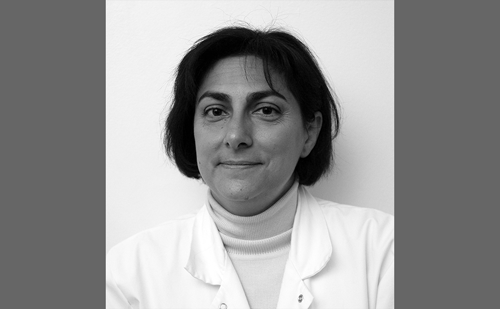Methods
Relevant publications were identified through searches of PubMed, Embase and the Cochrane Library using the following search terms: cataract, cataract surgery, postsurgical inflammation, anti-inflammatory and corticosteroid. Results were limited to English-language, peer-reviewed primary studies and reviews published between the years 2000 and 2010 (inclusive). Additional references were obtained by searching reference lists of identified articles.
Background
Methods
Relevant publications were identified through searches of PubMed, Embase and the Cochrane Library using the following search terms: cataract, cataract surgery, postsurgical inflammation, anti-inflammatory and corticosteroid. Results were limited to English-language, peer-reviewed primary studies and reviews published between the years 2000 and 2010 (inclusive). Additional references were obtained by searching reference lists of identified articles.
Background
Cataracts are a major cause of blindness and severe visual impairment, leading to bilateral blindness in an estimated 20 million people worldwide in 2004.1 Over half of all persons over the age of 65 develop age-related cataracts with visual disability.2 Globally, the number of cataract cases is expected to increase as populations age and lifespans increase.3 In the US alone, the number of persons with cataracts is projected to reach 30.1 million by 2020.4 Cataracts are the most common cause of vision loss in developed and developing countries.5,6
Identified risk factors for cataract formation include age, ethnicity, gender, genetic factors, smoking, exposure to sunlight, certain medications, nutrition, lower education and medical conditions such as diabetes, obesity, kidney disease, ocular trauma and hypertension.2,6 Complications from lack of treatment of cataract include sensitivity to glare, poor night vision and progressive vision loss. Individuals with hypermature cataract can develop lens-induced (phacoanaphylactic) persistent uveitis or glaucoma and persistent cataract-related inflammation can cause significant tissue damage.7
There is no medical treatment for cataracts.2,3 Non-surgical management of cataract includes counselling and use of spectacles or low-vision aids.6,8 Surgical removal of cataract remains the only treatment option for patients with failing vision.3 Cataract surgery is the most commonly performed surgical operation in the Western world.2,9 Small-incision cataract surgery using phacoemulsification has largely replaced extracapsular cataract extraction because of faster healing, smaller wounds and fewer resultant complications,3,6,8 with improved patient outcomes.10 However, post-operative complications, including ocular inflammation after cataract surgery, continue to cause visual impairment, pain and other sequelae among patients.
Discussion
Inflammation after Cataract Surgery
Ocular inflammation after cataract surgery is generally managed by topical anti-inflammatory drugs such as corticosteroids and/or non-steroidal anti-inflammatory drugs (NSAIDs).6 The duration and degree of post-operative anti-inflammatory therapy have been debated as improved surgical approaches have minimised the need for aggressive inflammation control after cataract surgery compared with previous surgical techniques.11 Despite surgical advances, post-cataract surgery inflammation is still a common cause of patient discomfort, delayed recovery and reduced visual outcome.12,13
The physical trauma associated with cataract surgery, including disruption of the blood–aqueous barrier (BAB), can induce an inflammatory response and the release of inflammatory mediators such as prostaglandins and leukotrienes from arachidonic acid (see Figure 1). Prostaglandins are released naturally from the iris and ciliary body and migrate to the retina after cataract surgery.14 The inflammatory response may lead to the activation of the immune cascade, involving neutrophils, macrophages, T lymphocytes and additional inflammatory mediators.11,14,15 Post-cataract surgery inflammation presents as protein flare and inflammatory cells in the anterior chamber, hyperaemia, miosis, oedema, leukocyte migration, fibroblast proliferation and scar formation, along with other local responses to the released pro-inflammatory cytokines.16,17 Persistent inflammation leads to higher rates of post-operative cystoid macular oedema (CMO), patient discomfort and compromised visual outcomes12,13,17 consequent to the breakdown of the blood–retinal barrier.18 Multiple potential complications of untreated post-operative inflammation include pain, photophobia, posterior synechiae, pseudophakic cellular precipitates, uveitis, elevated intraocular pressure (IOP) and glaucoma.6
The development of post-operative inflammation varies across patients (e.g., patients on prostaglandin treatment for glaucoma or hypertension before cataract surgery may be at higher risk of post-surgical inflammation and complications such as CMO).19 Pupillary constriction during extracapsular cataract extraction is mainly caused by prostaglandins resulting from surgical trauma, which can be prevented by pre-operative use of topical corticosteroids or NSAIDs.20–26 Patients with pre-existing inflammation in the eye, such as those with dysfunctional tear syndrome, are susceptible to increased inflammation following cataract surgery.27 Patients showing signs of rosacea, which correlates with a high incidence of evaporative dry eye syndrome, have significantly improved visual outcomes when treated with a corticosteroid prior to surgery.27 In dysfunctional tear syndrome, tear hyperosmolarity leads to production of pro-inflammatory mediators.27 Inhibiting this process with the use of pre-operative NSAIDs and corticosteroids may reduce the effects of dysfunctional tear syndrome as well as the risk of inflammation after cataract surgery.16,27,28
Cataract surgery is associated with a risk of ocular infection and toxic inflammation. Infectious and non-infectious aetiologies of ocular inflammation are treated differently.29 Infectious complications, such as post-operative endophthalmitis, may occur during any ocular surgical procedure.30,31 Common post-operative endophthalmitis infections are often caused by the entry into the intraocular space of bacteria that normally inhabit the lid and conjunctiva.32 Prevention with appropriate pre- and post-surgical antibiotics reduces the incidence of endophthalmitis and inflammation.30 Corticosteroids are often used in combination with antibiotics to treat inflammation due to endophthalmitis.30
Medical Approaches to Treatment of Inflammation following Cataract Surgery
There are no established treatment guidelines to prevent or reduce inflammation following ocular surgery.8,11 Therefore, treatment includes pre- and post-operative anti-inflammatory therapies such as corticosteroids and NSAIDs (see Table 1).8,11,23 Since it is impossible to predict which patients will develop clinically significant post-operative inflammation, anti-inflammatory agents are routinely used post-operatively.3,8,20,21 In some institutions, especially those in the UK, corticosteroids are the preferred option.3
Corticosteroids in the Control of Inflammation after Cataract Surgery
Corticosteroids are traditionally used for short-term control of ocular inflammation33 and are a mainstay of treatment regimens following cataract surgery.11 Compared with NSAIDs, corticosteroids have a wider range of activity in relieving inflammation (see Figure 1). Corticosteroids act to reduce inflammation at multiple points in the inflammatory cascade (see Table 1 and Figure 1), including both the cyclo-oxygenase pathway and the lipoxygenase pathway through inhibition of phospholipase A2, producing a reduction in both prostaglandins and leukotrienes.11
Safety of C-20 Ester Corticosteroids following Cataract Surgery
While the long-term use of corticosteroids may be associated with side effects such as elevated IOP, onset of glaucoma, aggravation of other disease states (including viral or fungal keratitis), cataract and a delay in the normal course of wound healing,33–35 the two- to six-week course of ophthalmic corticosteroid treatment following cataract surgery is generally effective yet short enough, sometimes, to avoid these concerns.11,12 However, the ability of certain topically administered corticosteroids to raise lOP, particularly in open-angle glaucoma patients, limits the usefulness of these potent anti-inflammatory agents.34 The propensity of corticosteroids to induce ocular adverse effects may also vary depending on whether or not the patient is a steroid responder.33,36,37 Table 2 presents the average increase in IOP for different corticosteroids in steroid-sensitive patients. This limitation of traditional corticosteroids led to the development of C-20 ester corticosteroids through retrometabolic drug design. One such C-20 ester corticosteroid, loteprednol etabonate (LE), is the Δ1-cortienic acid etabonate derivative of prednisolone acetate but with a 17α-chloromethyl ester at the C-20 position instead of a ketone (see Figure 2). This allows LE to be active at the glucocorticoid receptor, its site of action, and subsequently to undergo predictable hydrolysis to inactive carboxylic acid metabolites by naturally occurring ocular esterases. The rapid metabolism of LE results in a lower propensity to induce IOP elevation compared with C-20 ketone corticosteroids, even when administered to known corticosteroid responders.38 LE has been shown to be a safe corticosteroid when used to treat a number of ocular inflammatory conditions, including giant papillary conjunctivitis, seasonal allergic conjunctivitis, uveitis, dysfunctional tear syndrome and post-cataract surgery inflammation.20,21,27,38–45
In two similar clinical trials evaluating the use of LE for treating post-cataract inflammation, LE produced significantly lower rates of treatment-emergent adverse events compared with placebo (p<0.001 in study 1 and p=0.002 in study 2).20,21 There was no significant difference in mean change in IOP with LE compared with placebo and no evidence of deleterious effects on post-operative recovery.20,21 LE had a smaller impact on IOP increase than prednisolone acetate when these corticosteroids were compared in patients undergoing cataract surgery.46 Long-term (≥28 days) administration of either LE 0.2 or 0.5 % was associated with a low incidence of elevated IOP, which was comparable with placebo and lower than the rate observed with prednisolone acetate 1.0 %.47 LE (0.2 %) has reportedly been used for up to three years in patients with allergic conjunctivitis without inducing clinically significant elevated IOP (p=0.824).44
Efficacy of C-20 Ester Corticosteroids in Post-operative Inflammation
Post-operative corticosteroid treatment results in a reduced presence of inflammatory cells and flare within the anterior chamber compared with placebo.22–25 In the above clinical trials, LE was more effective than placebo in reducing anterior chamber cells and flare when used after cataract surgery in patients with a cumulative inflammation severity of at least grade 3 (on a scale of 0–9).20,21 A significantly greater proportion of LE-treated patients versus patients taking placebo achieved complete resolution of anterior chamber cells and flare (p<0.001 for both studies).20,21 By the final visit, 93 and 89 % of LE-treated patients compared with 65 and 64 % of vehicle-treated patients, respectively, had mild or resolved anterior chamber inflammation in each study.20,21 Reduction in severity for both cells and flare individually, on average, was greater in the LE group compared with the placebo group (see Figures 3 and 4; p<0.001 for both end points in both studies).20,21 There was no indication of rebound inflammation following the cessation of LE therapy. In other studies, LE was comparable with other corticosteroids in the effective reduction of inflammation following cataract surgery.46,48
Non-steroidal Anti-inflammatory Drugs
NSAIDs are cyclo-oxygenase inhibitors that work by suppressing production of prostaglandins. They are used before and after cataract surgery to prevent and reduce inflammation (see Table 1).49–52 NSAIDs have demonstrated suppression of ocular inflammation following cataract and refractive surgery in patients.53,54 NSAIDs control ocular pain and have similar activity against inflammation compared with corticosteroids.49,52 A few cases of corneal melting and perforation have been reported in patients treated with NSAIDs,55 although these were primarily limited to a specific diclofenac formulation marketed only in the US and subsequently withdrawn (Falcon Pharmaceuticals, Fort Worth, TX). Nevertheless, due to a potential class effect of corneal toxicity and melting with NSAIDs, the use of NSAIDs in patients with pre-existing compromised corneal epithelium may need to be limited (unless the risk of CMO outweighs the risk of corneal adverse events). In a recent review, bromfenac twice daily (BID) was found to demonstrate an early and sustained level of clinical activity with little burning and stinging and minimal adverse events in the treatment of ocular inflammation following cataract surgery.56 Preclinical studies with bromfenac demonstrated that the addition of bromine increased ocular penetration, suggesting that bromfenac BID may be as potent as other NSAIDs administered more frequently but with less potential for corneal toxicity. Bromfenac became available in the EU in 2011.
Topical Non-steroidal Anti-inflammatory Drugs Compared with Topical Corticosteroids in the Treatment of Post-operative Inflammation
The efficacy of ketorolac tromethamine 0.5 % was compared with LE (0.5 %) in controlling inflammation after cataract surgery in 60 patients pre-operatively and one, three, seven and 30 ± 7 days post-operatively.57 There was no statistically significant difference in post-operative inflammation (objective or subjective cell and flare measurements) or IOP between the two groups.57 A prospective randomised double-masked study compared ketorolac tromethamine (0.5 %) with prednisolone acetate (1 %) in controlling inflammation after cataract surgery in 59 patients for 28 days. Ketorolac was as effective and well tolerated as prednisolone in controlling post-operative inflammation and pain after cataract surgery.58 Ketorolac tromethamine (0.5 %) and rimexolone 1 % were compared for controlling post-operative inflammation in 36 patients that had undergone cataract surgery; there were no statistically significant differences between the groups in cells, flare or IOP.59
The efficacy of indomethacin 0.1 % was compared with that of dexamethasone 0.1 % in a randomised double-masked study of 145 patients undergoing cataract surgery.60 Protein flare and cells decreased in both groups, with a difference in favour of indomethacin for cells at post-operative day 30 (p=0.046). Both drugs were well tolerated but conjunctival hyperaemia was less pronounced in the dexamethasone group on post-operative day 30 (p=0.046).
The anti-inflammatory effects of bromfenac 0.1 %, betamethasone 0.1 % or both were compared in 72 post-cataract patients up to two months post-operatively.55 There were no statistically significant differences among treatment groups in best corrected visual acuity, IOP and aqueous flare or corneal thickness. CMO was noted in one eye in the betamethasone monotherapy treatment group.
Diclofenac 0.1 % and dexamethasone 0.1 % were equally effective in reducing inflammation in post-cataract patients (n=180) as measured with laser flare photometry at days three and eight and at two weeks and one month following cataract surgery, while both were more effective than placebo. Mean IOP was statistically significantly higher in dexamethasone-treated patients.22 Comparison of diclofenac 0.1 % and betamethasone 0.1 % in preventing CMO and BAB disruption after small-incision cataract surgery demonstrated a lower incidence of fluorescein angiographic CMO in the diclofenac group (18.8 %) than in the betamethasone group (58.0 %) (n=150, p<0.001).61 There was significantly less anterior chamber flare in the diclofenac group than in the betamethasone group (p<0.05) at one and two weeks, while IOP was significantly higher in the betamethasone group at eight weeks (p=0.0003).61 Surface inflammation and patient comfort were not assessed in this study.61
Efficacy, safety and patient comfort were evaluated in two corticosteroids – prednisolone 1 % and rimexolone 1 % – and ketorolac tromethamine 0.5 %, after extracapsular cataract extraction. The assessment of cells did not differ among the treatments (p=0.165). Flare in the anterior chamber was lowest with ketorolac tromethamine (p=0.008) and surface inflammation was lowest with prednisolone (p=0.002). One patient in the prednisolone group had elevated IOP; among the remaining patients, those in the ketorolac tromethamine group had higher IOP than those in the two corticosteroid groups (p=0.030). One patient receiving ketorolac tromethamine developed corneal erosion. The best control of surface inflammation and highest patient comfort were achieved with prednisolone (p=0.041).62
Topical Non-steroidal Anti-inflammatory Drugs in Combination with Topical Corticosteroids in the Treatment of Post-operative Inflammation
Because NSAIDs and corticosteroids have different mechanisms of action, they may be synergistic in the prevention and treatment of ocular inflammation after cataract surgery. In a retrospective chart review of 450 consecutive patients who had uncomplicated cataract surgery, those patients treated with prednisolone alone had a higher incidence of visually significant macular oedema as documented by optical coherence tomography (OCT) compared with those treated with both prednisolone and nepafenac (five patients versus no patients, respectively, p=0.0354).63 In a clinical trial investigating the use of ketorolac (0.4 %) in combination with prednisolone acetate (1 %), a notably reduced mean retinal thickening was observed through OCT in patients receiving combination therapy compared with patients receiving only prednisolone acetate (3.9 versus 9.6 μm, p=0.003).64 No patients in the combination group and five patients in the prednisolone group developed clinically apparent CMO (p=0.032). Treatment with peri-operative ketorolac and post-operative prednisolone acetate significantly reduced the incidence of both CMO and macular thickening in cataract surgery patients, indicating that the combination of a corticosteroid and an NSAID was synergistic in the prevention of inflammation following surgery.64 Similarly, treatment with diclofenac for two days pre-operatively and four weeks post-operatively plus steroid post-operatively reduced the incidence of CMO in a study of 60 patients undergoing small-incision cataract surgery as compared with treatment with diclofenac and steroid post-operatively only. None of the patients in the group receiving peri-operative diclofenac developed CMO compared with 12 % of the patients in the group receiving post-operative treatment only.65
In a study in rabbits, NSAID therapy (suprofen) was shown to be effective when started 48 hours prior to the induction of inflammation; however, it was ineffective when administered immediately after induction of inflammation. In contrast, corticosteroid therapy (prednisolone acetate) was markedly effective, both when used after the induction of inflammation and when initiated 48 hours previously. When administered together, NSAID plus corticosteroid therapy was more effective for mean decrease in corneal inflammatory activity in rabbits than treatment with either drug alone, regardless of whether therapy was initiated before or after the inflammatory event.66
These studies demonstrate that NSAIDs may work synergistically with corticosteroid therapy to provide effective control of inflammation and its effect on macular thickness after cataract surgery.55,63–66 Moreover, combination NSAID/steroid therapy in the setting of acute, visually significant pseudophakic CMO appears to offer treatment benefits over monotherapy regimens.67,68
Summary
Corticosteroids and NSAIDs are the mainstay topical therapies for post-operative inflammation following cataract surgery. While corticosteroids have a broader mechanism of action – inhibiting both the cyclo-oxygenase and lipoxygenase pathways through inhibition of phospholipase A2 – traditional corticosteroids are limited in that they lead to elevated IOP. Use of LE, a C-20 ester corticosteroid, in the prophylaxis and control of post-cataract surgery inflammation leads to more favourable safety outcomes compared with C-20 ketone corticosteroids. Different forms of monotherapy with corticosteroids or NSAIDs have been compared in the prophylaxis and control of post-cataract surgery inflammation. Although all the active agents were more effective than placebo in controlling inflammation, used together these drugs may work synergistically to offer more effective control of inflammation and prevention of CMO. Because LE has been shown to have a better safety profile in the control of inflammation following cataract surgery compared with prednisolone and other C-20 ketone corticosteroids, it may be a better option when used in combination with an NSAID. However extended use requires careful monitoring and reporting. An effective anti-inflammatory treatment regimen, with an improved safety profile that does not significantly elevate IOP, is useful for preventing further inflammation-related complications after cataract surgery. ■







